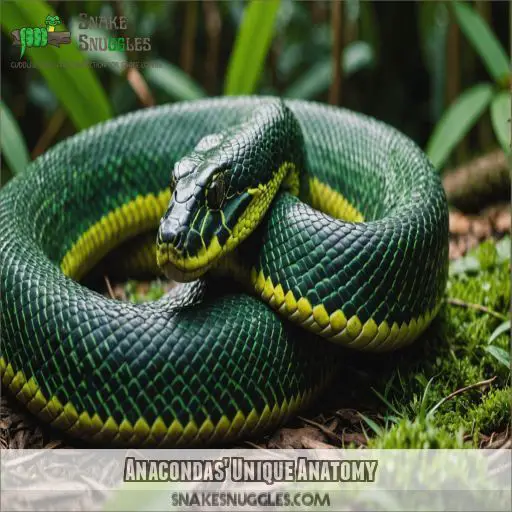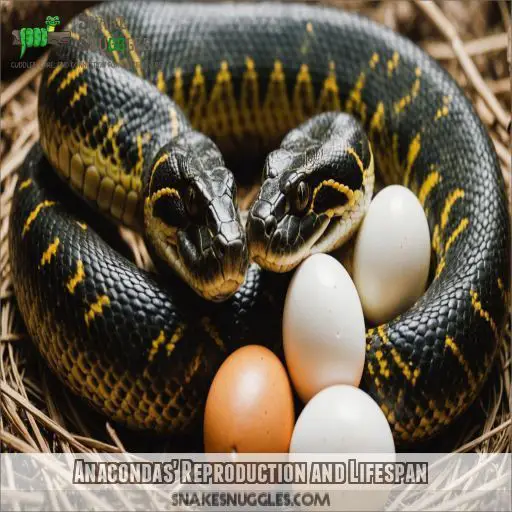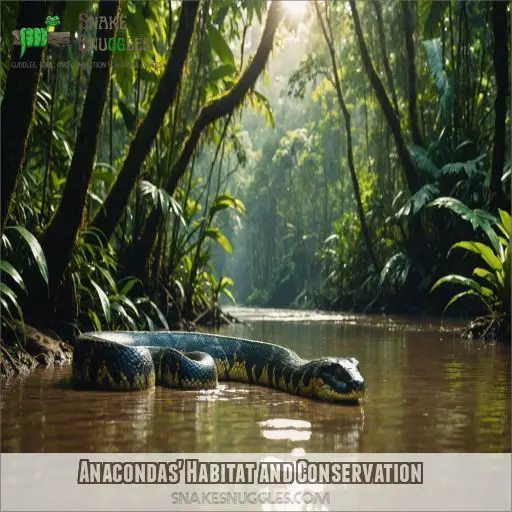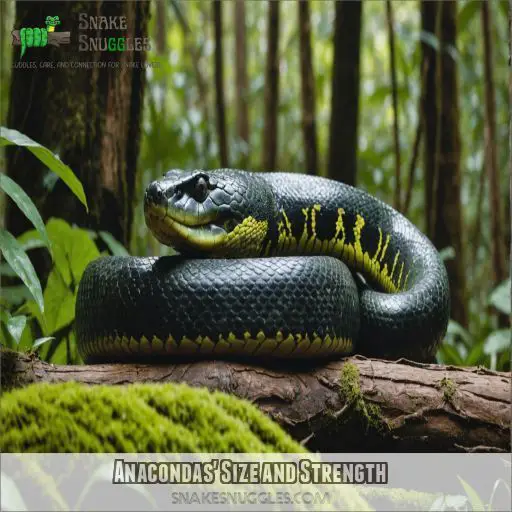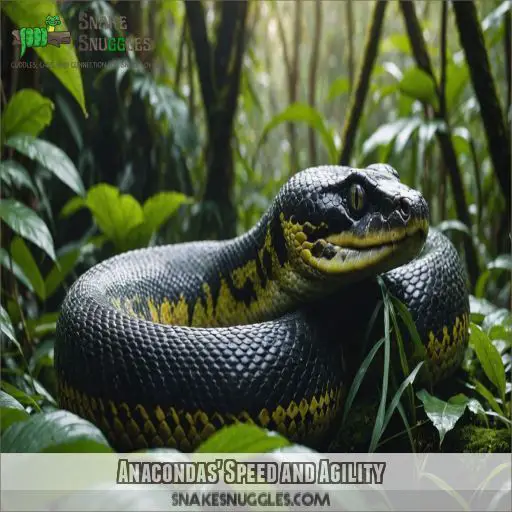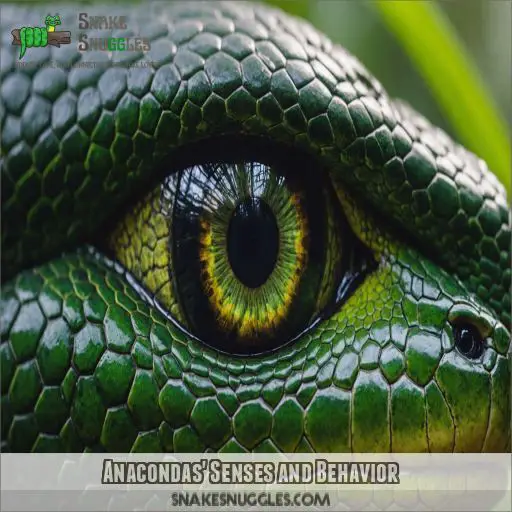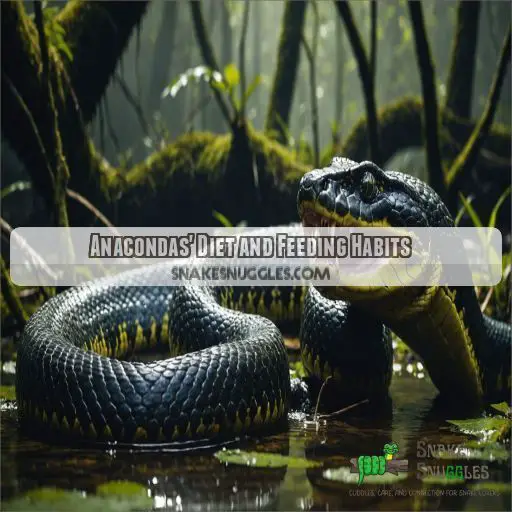This site is supported by our readers. We may earn a commission, at no cost to you, if you purchase through links.
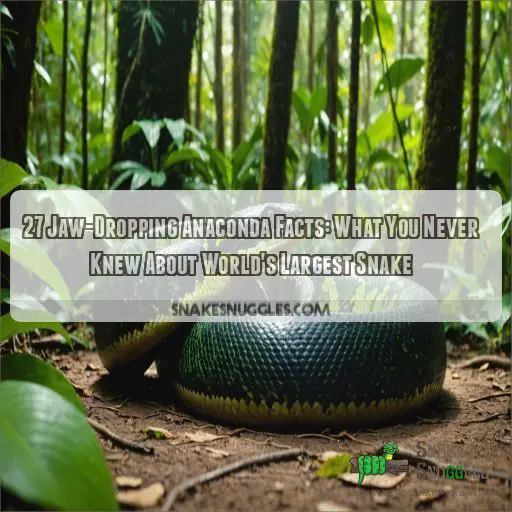
Table Of Contents
- Key Takeaways
- Anacondas’ Unique Anatomy
- Anacondas’ Hunting and Diet
- Anacondas’ Reproduction and Lifespan
- Anacondas’ Habitat and Conservation
- Anacondas’ Size and Strength
- Anacondas’ Speed and Agility
- Anacondas’ Senses and Behavior
- Anacondas’ Diet and Feeding Habits
- Anacondas’ Unique Characteristics
- Anacondas in the Wild and Captivity
- Frequently Asked Questions (FAQs)
- What are 10 facts about anacondas?
- Do anacondas have 100 teeth?
- What is special about anacondas?
- How fast are anacondas?
- How do anacondas protect themselves from predators and threats?
- Can anacondas be tamed and kept as household pets?
- What is the average cost of purchasing an anaconda?
- How do anacondas adapt to living in different environments?
- Are anacondas social animals or do they live alone?
- Conclusion
Key Takeaways
- You’ve got to admire anacondas’ impressive size – they’re the heaviest snakes in the world, with a record-breaking weight of 550 pounds and a length of 28 feet. But what’s even more fascinating is how they use their massive bodies to their advantage, employing stealthy ambush tactics to catch their prey off guard.
- Anacondas’ heat-sensing abilities are truly one of a kind. They can detect infrared radiation from prey, even underwater, and their heat-sensing pits are more sensitive than those of wild cats. This superpower helps them navigate their surroundings and pinpoint warm-blooded prey with ease.
- You might be surprised to learn that anacondas are expert swimmers, and can even hold their breath for up to 10 minutes while swimming. Their webbed feet and camouflage make them nearly invisible among aquatic plants, allowing them to sneak up on unsuspecting prey.
- Despite their fearsome reputation, anacondas are actually pretty laid-back when it comes to eating. They can survive for months on a single meal, thanks to their slow digestion, and can even swallow prey whole. Talk about a long lunch break!
Anacondas’ Unique Anatomy
You’re about to meet the largest snake in the world, the Eastern Indigo counterpart, and it’s a whole lot more fascinating than you ever imagined – get ready to be amazed by the incredible anatomy of anacondas
! As we explore the unique body structure and specialized features of these massive serpents, you’ll discover just what makes them the ultimate predators in their Amazonian habitat.
Body Structure and Scales
You might be surprised to learn that anacondas have some serious armor – their bodies are covered in small, olive-green scales that provide perfect camouflage in the water. But what’s really cool is that these scales are constantly being replaced through a process of skin shedding, which helps keep their skin healthy and shiny.
Heat-Sensing Abilities and Hunting Style
You might be wondering how anacondas catch their prey. It’s all about heat-sensing abilities. These semi-aquatic snakes use thermal detection to track warm-blooded animals. Here are three mind-blowing facts about anacondas’ hunting style:
- They can detect infrared radiation from prey, even underwater.
- Their heat-sensing pits are more sensitive than those of wild cats.
- Anacondas are ambush predators, using stealth techniques to sneak up on unsuspecting animals.
Stealthy Nature and Ambush Predation
You’re about to uncover the secret to anacondas’ sneaky hunting skills. As stealthy predators, they rely on ambush tactics, using their aquatic environment to their advantage. With their semi-aquatic lifestyle and low metabolism, they can remain submerged for up to 10 minutes, waiting for the perfect moment to strike. Their webbed feet and camouflage make them nearly invisible among aquatic plants.
Adaptation to Aquatic Environment
You’re about to discover the anaconda’s secret to thriving in the aquatic environment. These stealthy hunters have adapted to life in the water with remarkable features, including:
- Aquatic camouflage: blending in with murky waters
- Water sensitivity: detecting vibrations in the water
- Submerged hunting: lying in wait underwater
- Scale adaptation: smooth scales for reduced drag
- Underwater movement: undulating bodies for efficient swimming
Anacondas’ Hunting and Diet
You’re about to discover the fascinating world of anacondas’ hunting and diet, where these stealthy giants rule the Amazonian waters with their powerful constriction abilities and flexible jaws. From swallowing prey whole to surviving months without a meal, you’ll learn the surprising ways anacondas thrive as opportunistic ambush predators in their tropical habitat.
Constriction Method of Killing Prey
When anacondas hunt, they use a stealthy constriction method to kill their prey.
You might think it’s suffocation, but they actually cut off blood flow to the brain, making it a swift and efficient kill.
With lightning-fast constriction speed, they immobilize their prey, and their hunting strategy is a true marvel of nature, making them one of the most efficient predators.
Flexible Jaws and Swallowing Prey Whole
You’re probably wondering how anacondas manage to swallow their prey whole. It’s all about their incredibly flexible jaws! Thanks to stretchy ligaments, they can open their mouths wide enough to consume prey much larger than themselves. Here are three mind-blowing facts about anacondas’ jaw structure:
- Anacondas can swallow prey up to 75% their own size.
- Their jaws can stretch up to 3 times their normal width.
- This unique adaptation allows them to eat large prey, like capybaras, in one swift motion.
Opportunistic Ambush Predators
How do anacondas catch their prey so effortlessly? As opportunistic ambush predators, they lie in wait, submerged in water, until an unsuspecting animal approaches the water’s edge to drink. With lightning-fast speed, they strike, wrapping their massive bodies around their prey. This stealthy hunting strategy has made them one of South America’s top predators.
Variety of Prey and Feeding Habits
You might wonder what’s on the menu for these massive serpents. Anacondas aren’t picky eaters – they munch on fish, reptiles, amphibians, birds, and mammals. They even gobble up capybaras, the world’s largest rodents, which weigh over 150 pounds! Their flexible jaws can stretch to accommodate prey nearly as large as their own body. Talk about a stretchy stomach!
Anacondas’ Reproduction and Lifespan
You’re about to learn some jaw-dropping facts about anacondas’ reproduction and lifespan. Get ready to be amazed by the fascinating mating habits and impressive longevity of these massive snakes!
You’ll discover the intricacies of anacondas’ polyandrous nature.
You’ll also learn about live birth and clutch size, gestation period, and the surprising differences between their lifespan in captivity versus the wild.
Mating Habits and Polyandrous Nature
Imagine being the queen of the Amazon – that’s what female anacondas are during mating season.
They are polyandrous, meaning they mate with multiple males.
This boosts offspring survival rates.
Male anacondas engage in intense wrestling matches for the right to mate.
Ultimately, the female calls the shots, showcasing a unique display of female dominance in the animal kingdom.
Live Birth and Clutch Size
You’re now a part of the anaconda’s intimate life. After the intense wrestling matches, the female anaconda gives birth to live young. The clutch size can range from 3 to 40 babies, with an average of 20-40. Here are some fascinating facts about anaconda births:
- Anacondas can have up to 80 babies in a single clutch.
- Newborns are about 60 cm long and totally adorable.
- Female anacondas typically breed in alternate years, conserving energy.
- The breeding season impacts the clutch size, with larger clutches in the dry season.
Gestation Period and Female Reproductive Cycle
Ever wonder what’s brewing inside a pregnant anaconda? Female anacondas are typically pregnant for about 6-7 months after mating, which usually occurs during the dry season. After giving birth to live young, they can have up to 40 babies in a clutch! Talk about a big family. This remarkable reproductive cycle is a clear example of anacondas’ incredible adaptability.
Lifespan in Captivity and Wild
You’re probably wondering how long anacondas live. In captivity, they can thrive for up to 30 years, but in the wild, their lifespan is much shorter, typically ranging from 10 to 12 years. Here are some key factors that impact an anaconda’s lifespan:
- Captive vs. Wild: Human care vs. harsh environments
- Lifespan Factors: Diet, habitat, and health conditions
- Diet Impact: Nutrient-rich food vs. scarce prey
- Stress Levels: High stress can shorten an anaconda’s life
Anacondas’ Habitat and Conservation
You’re about to enter the domain of the anacondas – the Amazon rainforest and wetlands of South America, where these massive serpents reign supreme. As you explore their habitat, you’ll also learn about the serious threats they face, from the exotic pet trade and habitat loss to wildfires and agricultural expansion, and what’s being done to conserve these incredible creatures.
Amazon Rainforest and Wetland Habitats
You’re about to enter the domain of the majestic anaconda – the Amazon rainforest and wetlands. Imagine a lush, vibrant world teeming with life, where tropical wildlife and Amazonian plantlife thrive.
| Amazon Rainforest Features | Wetland Characteristics |
|---|---|
| Towering trees, dense foliage | Shallow waters, muddy banks |
| Exotic flowers, medicinal plants | Aquatic life, fish, and birds |
| Diverse wildlife, including monkeys | Anacondas’ favorite hunting grounds |
Here, anacondas reign supreme, their massive bodies gliding effortlessly through the murky waters.
Threats From Exotic Pet Trade and Habitat Loss
You’re about to uncover the dark side of anaconda conservation. The exotic pet trade and habitat loss are major threats to these incredible creatures. Here’s what’s at stake:
- Poaching effects: anacondas are hunted for their skin and meat
- Habitat fragmentation: their homes are being destroyed and fragmented
- Trade regulations: lax laws allow anacondas to be sold as pets
- Captivity issues: anacondas don’t thrive in captivity, leading to a life of suffering
Vulnerability to Wildfires and Agricultural Expansion
You’re learning about the threats anacondas face, and it’s time to talk about their vulnerability to wildfires and agricultural expansion. As their habitats shrink due to land conversion, anacondas become more susceptible to devastating fires. Habitat fragmentation makes it harder for them to escape, and smoke impact can be deadly. Fire prevention and refuge creation are indispensable to their survival.
Conservation Status and Efforts
You might be wondering about anacondas’ conservation status – unfortunately, it’s currently unknown. To change this, we need more research funding and habitat preservation efforts. Supporting organizations that combat Snake Trafficking and create wildlife reserves can also make a big difference. Community engagement is key, too, in promoting coexistence with these majestic creatures.
Anacondas’ Size and Strength
You’re about to meet the largest snake in the world by weight, and possibly the longest – the anaconda. Get ready to discover just how massive these serpents can grow, and what makes them so formidable, from record-breaking lengths to their powerful constriction abilities.
Record-Breaking Length and Weight
You’re probably wondering just how massive anacondas can get. The largest recorded anaconda measured 28 feet long and 44 inches thick, making them one of the massive snake species in the world . Here are some mind-boggling facts to help you visualize their size:
- 28 feet is as long as a school bus.
- 44 inches is as thick as a grown man’s thigh.
- Anacondas can weigh up to 550 pounds, equivalent to the weight of a grand piano (Source).
Comparison to Other Boa Constrictors
| Snake Species | Average Length | Average Weight |
|---|---|---|
| Green Anaconda | 17-20 feet | 100-200 pounds |
| Dark-Spotted Anaconda | 15-18 feet | 70-150 pounds |
| Yellow Anaconda | 12-15 feet | 40-80 pounds |
| Boa Constrictor | 10-13 feet | 20-50 pounds |
| Python | 15-20 feet | 50-100 pounds |
As you can see, anacondas are the clear winners when it comes to size!
Powerful Constriction Ability
Imagine being squeezed by a 28-foot-long, 550-pound giant – that’s what anacondas’ prey face. Their powerful constriction ability allows them to kill by cutting off blood flow to the brain, rather than suffocating their prey . With a deadly grip, anacondas can exert immense pressure, making them one of the most formidable predators in the animal kingdom.
Anacondas’ Speed and Agility
As you explore the fascinating world of anacondas, you’ll discover that their speed and agility are just as impressive as their massive size.
From slithering through the water with ease to quickly wrapping their bodies around unsuspecting prey, anacondas’ unique physiology allows them to move with surprising speed and stealth.
Making them one of the most formidable predators in the animal kingdom.
Movement on Land and Water
You’re probably wondering how anacondas move on land and water with such massive bodies. Well, these aquatic adaptations enable them to navigate through the water with ease. On land, they’re surprisingly fast, with a terrestrial speed of about 1.5 miles per hour. Here are three mind-blowing facts about anacondas’ movement:
- They can hold their breath for up to 10 minutes while swimming.
- Anacondas use a unique form of limbless locomotion to move on land.
- In the water, they can swim at speeds of up to 15 miles per hour.
Undulation and Muscle Structure
You’re probably wondering how anacondas move with such stealth and agility. It’s all about their muscle structure and undulation! By contracting and relaxing their muscles in a wave-like pattern, they propel themselves through water with incredible efficiency. This aquatic adaptation allows them to navigate their surroundings with ease, making them formidable hunters in their natural habitat.
Speed and Stealth in Hunting
As you learn about anacondas, you’ll discover their speed and stealth in hunting is unmatched. These massive snakes can move swiftly through water, using their camouflage to sneak up on prey. With ambush tactics and hunting strategies that involve stealthy movement and prey tracking, anacondas can catch their next meal in the blink of an eye.
Anacondas’ Senses and Behavior
You’re about to discover the fascinating world of anacondas’ senses and behavior, where these massive snakes use their incredible heat-sensing abilities to track down prey and navigate their surroundings. As you explore this topic, you’ll learn how anacondas utilize their tongues and Jacobson’s organ to gather information, and even get a glimpse into their surprisingly social behavior and interactions.
Heat-Sensing Abilities and Navigation
Ever wondered how anacondas track their prey with uncanny precision? It’s all about their heat-sensing abilities! Like pit vipers, anacondas possess infrared vision, which allows them to detect the slightest changes in temperature. This thermoreception helps them navigate their surroundings and pinpoint warm-blooded prey, making them formidable hunters in their aquatic domain.
Use of Tongue and Jacobson’s Organ
Get ready to uncover the secrets of anacondas’ superpower senses. As you explore the lives of these massive snakes, you’ll discover how they use their tongues and Jacobson’s organ to detect chemical cues, locate prey, and navigate their surroundings.
- The Jacobson’s organ is a specialized sensory organ found in the roof of a snake’s mouth.
- Anacondas flick their tongues in and out to collect chemical samples from the air.
- These chemical cues help anacondas detect the presence of prey, predators, and potential mates.
- By analyzing these chemical signals, anacondas can build a mental map of their environment and make informed decisions.
Social Behavior and Interaction
When you learn about anacondas, you’ll find that these massive snakes aren’t exactly social butterflies. They’re mostly solitary animals, only coming together for mating rituals. But don’t think they’re completely antisocial – anacondas have been known to engage in some pretty intense territorial disputes, and they even exhibit parental care by guarding their young after birth.
Anacondas’ Diet and Feeding Habits
As you explore the fascinating world of anacondas, you’ll discover that their diet and feeding habits are just as impressive as their massive size. From swallowing prey whole to surviving for months without eating, you’ll be amazed at the unique adaptations that make anacondas one of the most formidable predators in the animal kingdom.
Hunting Strategy and Ambush Tactics
You’re about to uncover the sneaky ways anacondas catch their prey. Their hunting strategy is all about stalking and ambushing unsuspecting animals that come to drink or cross the water. With their stealthy approaches and patient predation, anacondas are the ultimate aquatic ambush predators.
- They use their heat-sensing pits to detect warm-blooded prey.
- Their eyes and nostrils are on top of their head, allowing them to stay mostly submerged.
- Anacondas can remain underwater for up to 10 minutes, waiting for the perfect moment to strike.
- Their powerful tails help them quickly snatch and constrict their prey.
Swallowing Prey Whole and Digestion
Now that you’ve learned about anacondas’ sneaky hunting tactics, let’s explore how they devour their prey whole. With their incredibly flexible jaws, anacondas can swallow animals up to 75% their own size. Their digestive system is designed for slow digestion, allowing them to survive for months on a single meal. Talk about a long lunch break!
Anacondas’ Unique Characteristics
As you explore the fascinating world of anacondas, you’ll discover some truly jaw-dropping characteristics that set these massive snakes apart from the rest. From their specialized scales and camouflage abilities to their distinctive patterns and coloration, anacondas have evolved some remarkable traits that help them thrive in their aquatic environment.
Specialized Scales and Camouflage
Ever wondered how anacondas blend in with their surroundings? Their specialized scales play a huge role! With a unique texture and mottling effects, these massive snakes can camouflage themselves in the water, waiting for unsuspecting prey. Their scale pattern variation also helps them adapt to different aquatic environments, making them expert hunters in their domain.
Distinctive Patterns and Coloration
You’re now familiar with anacondas’ scaly camouflage, but have you ever wondered about their distinctive patterns and coloration? Their skin pigmentation is a remarkable example of adaptation, with pattern variations that help them blend in. Anacondas exhibit a range of color morphs, from olive-green to dark-spotted, and even shed their skin to reveal new, vibrant patterns.
Anacondas in the Wild and Captivity
You’re about to enter the fascinating world of anacondas in their natural habitat and in captivity, where you’ll discover how these incredible creatures thrive in the wild.
From the lush Amazon rainforest to breeding programs in zoos, let’s explore the amazing lives of anacondas.
What’s being done to safeguard their survival is also part of this exploration, highlighting the conservation efforts working to protect them.
Distribution and Habitat in the Wild
You’re probably wondering where these massive snakes call home. Anacondas are found in the Amazon rainforest, where they inhabit shallow waters and wetlands. Here are some interesting facts about their habitat:
- They’re native to South America, with a range spanning across nine countries.
- Anacondas can thrive in various aquatic environments, from slow-moving rivers to stagnant swamps.
- Their habitat range is expanding, but wetland loss threatens their populations.
Conservation Efforts and Threats
Here’s the lowdown on anaconda conservation: protecting their habitats is key. Human conflict, wildlife trade, and climate change threaten these incredible snakes. Community engagement is vital – by supporting conservation efforts, you can help safeguard anacondas’ homes. It’s time to take action and secure the long-term survival of these majestic creatures and their habitats.
Captivity and Breeding Programs
You’re probably wondering how anacondas thrive in captivity. Well, it’s no easy feat! Breeding programs face numerous challenges, from simulating natural habitats to managing finicky diets. Here are some fascinating facts about captive anacondas:
- Breeding Program Challenges: Replicating the anaconda’s natural environment is key to successful breeding.
- Captive Diet Management: Anacondas require a varied diet, including fish, birds, and small mammals.
- Anaconda Enclosure Design: Spacious enclosures with water features and hiding places are vital for stress-free living.
- Snake Handling Safety: Expert handlers use specialized equipment to guarantee safe interactions with these massive snakes.
Frequently Asked Questions (FAQs)
What are 10 facts about anacondas?
Did you know anacondas can grow up to 30 feet long? Here are 9 more facts: they’re expert swimmers, can eat prey whole, have heat-sensing abilities, and can survive months without eating after a big meal .
Do anacondas have 100 teeth?
You’re curious about anacondas’ teeth, right? Well, anacondas have up to 100 aglyphous teeth , which are arranged in four rows at the top and two rows at the bottom .
What is special about anacondas?
You’re about to meet the ultimate aquatic hunters – anacondas! These massive snakes have heat-sensing abilities, can stay submerged for up to 10 minutes, and swallow prey whole, making them stealthy predators in their South American habitat .
How fast are anacondas?
You’re curious about anacondas’ speed! As a semi-aquatic snake, anacondas aren’t exactly sprinters, but they can move stealthily through water at about 15 miles per hour and slither on land at approximately 2 miles per hour.
How do anacondas protect themselves from predators and threats?
When you learn about anacondas, you’ll discover that they protect themselves from predators and threats by using their massive size, stealthy nature, and camouflage abilities, and also by escaping into the water or burrowing into mud.
Can anacondas be tamed and kept as household pets?
Imagine having a 28-foot slithery roommate! Unfortunately, anacondas don’t make great household pets. They’re wild animals with complex needs, requiring a lot of space, specific temperatures, and a varied diet of live prey, making them a challenging and potentially hazardous companion.
What is the average cost of purchasing an anaconda?
You’re interested in purchasing an anaconda, but be aware that prices vary depending on the species, size, and location. On average, you can expect to pay between $100 to $500 for a pet anaconda .
How do anacondas adapt to living in different environments?
You’ll be amazed at how anacondas adapt to living in different environments! They use their incredible camouflage, heat-sensing abilities, and flexible bodies to thrive in both water and on land .
Are anacondas social animals or do they live alone?
You’re curious about anacondas’ social lives! Well, they’re actually solitary creatures, only coming together to mate . Imagine having a vast territory all to yourself – that’s the life of an anaconda! .
Conclusion
Discovering that anacondas can survive for months on a single meal is mind-boggling, right? As you’ve dived into these 27 interesting facts about anacondas, you now know what makes them the heaviest snakes in the world. From their incredible heat-sensing abilities to their stealthy ambush predation, anacondas are truly one of a kind. Exploring these 27 jaw-dropping anaconda facts has transformed your understanding of these incredible creatures, and it’s clear why they’re the world’s largest snake.

